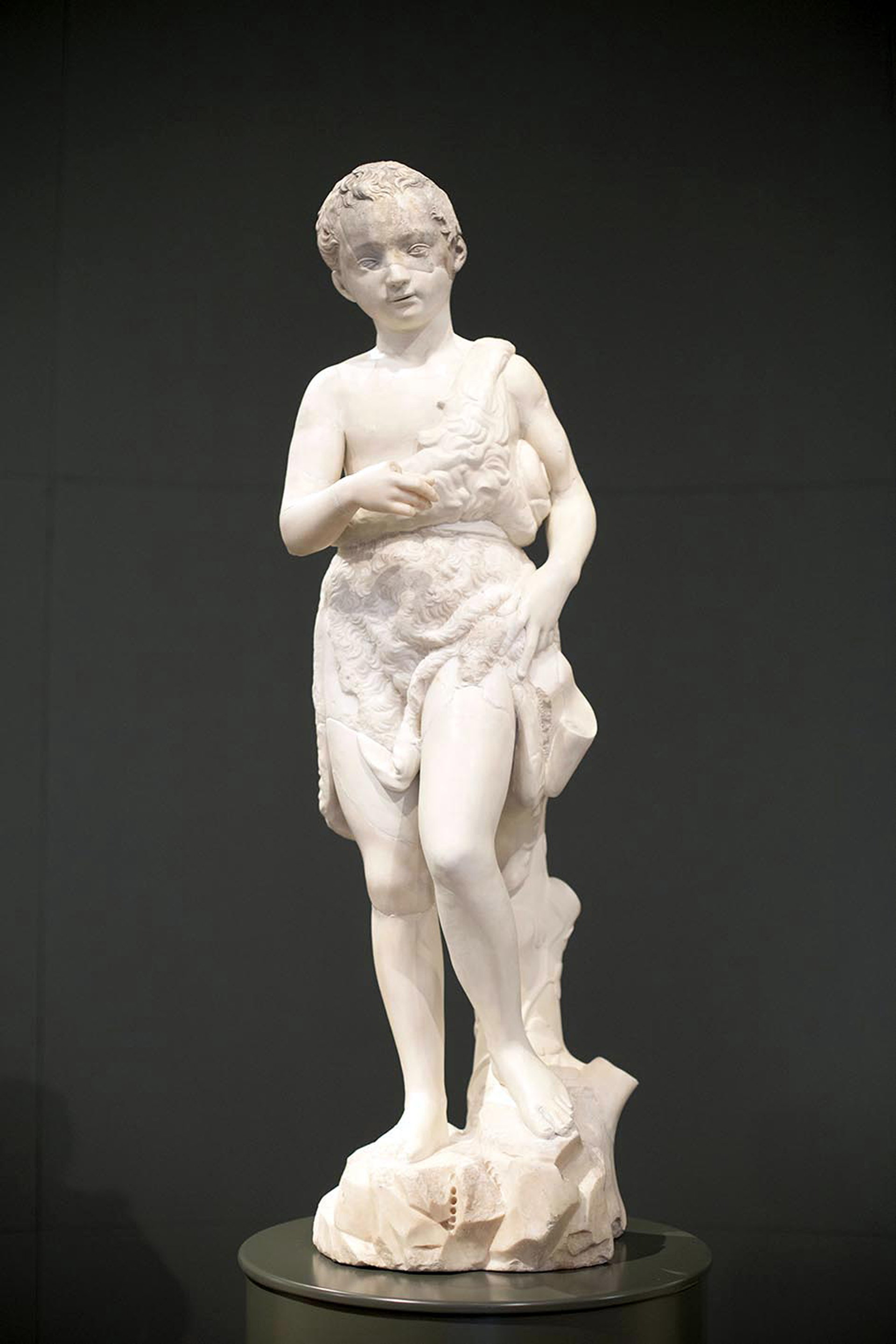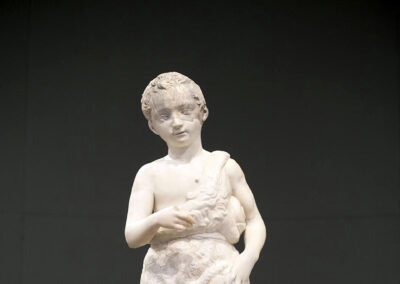The biographers of Michelangelo (1475-1564), Giorgio Vasari (1550) and Ascanio Condivi (1553), tell us that in 1495, on his return to Florence from Bologna, he sculpted a "San Giovaninno" for Lorenzo de Pierfrancesco de' Medici, a cousin of Lorenzo "the Magnificent", educated in his house, remembered for the protection he gave Sandro Boticelli and known as "Il Popolano" for his support of the Florentine Republic, which he supported, a cousin of Lorenzo "the Magnificent", educated in his house, remembered for his protection of Sandro Boticelli and known as "Il Popolano" for his support of the Florentine Republic which expelled the older branch of the Medici from the city. It is significant that during Michelangelo's lifetime neither of his two biographers made any mention of the sculpture's whereabouts, an indication that it had disappeared from the Italian scene.
Practically since the birth of Art History as an academic discipline, specialists have been searching for this piece, proposing various candidates. In 1930, Manuel Gómez Moreno proposed in an article in the journal Archivo Español de Arte this San Juan Bautista Niño from the Sacred Chapel of the Saviour as the lost San Juanito mediceo, which found a certain echo in national historiography, but very little in international historiography, as it was based solely on a cursory stylistic analysis and obviated any historical analysis that would explain the routes by which the San Juanito could have reached the Chapel of the Saviour. The destruction of the piece on 26 July 1936 further complicated the chances of success of Gómez Moreno's attribution, as international historiography could only rely on the only image published in the magazine, which prevented any real idea of its sculptural quality. In 2013, Francesco Caglioti, professor at the Federico II University of Naples, in two articles published almost simultaneously, returned to this issue and confirmed Gómez Moreno's intuition with a convincing argument, which we summarise below.
Caglioti considers that the errors of attribution of the candidates proposed to date had their origin in the fact that the stylistic assumptions of the mature Michelangelo, "cinquecento", and not from the perspective of the "quattrocento", were being used in the search for the St. Johnny. Hence, a significant number of the proposed candidates were, in the end, works from the 16th or even the 17th century.
For this reason, his research begins with an iconographic, stylistic and qualitative analysis of the Saint John the Baptist in the Chapel of the Saviour by comparing it with Michelangelo's youthful work. For this exercise he uses the seventeen photographs that, together with the Opificio delle Pietre Dure in Florence, they have managed to collect of the San Juanito prior to 1936, a collection that includes almost all the 360-degree perspectives of the work. They show, by means of numerous examples and analogies, that, stylistically and qualitatively, the ubetense San Juanito matches perfectly with other sculptures and paintings by Michelangelo, but especially with the sculpture of Bacchus (Museo del Bargello, 1497-8) and with the painting called Madonna of Manchester (National Gallery 1495-6), which allows the piece to be dated to around 1495-96, precisely the years in which both Ascanio Condivi and Giorgio Vasari dated the San Giovaninno mediceo.
The inventories of the late 15th and 16th centuries show that the Michelangelo's San Giovanni was in the residence of the minor "Popolani" branch of the Medici family until at least 1537. The entire patrimony of this branch of the family passed, in that same year of 1537, from Lorenzino, who fled Florence after the murder of Duke Alessandro, to Cosimo I, the only legitimate descendant of this Medicean lineage remaining in Florence. Significantly, in 1541, Cosimo I had to ask the Martelli family for a Saint John by Donatello to be placed at the centre of the baptismal apparatus of his first-born son, Francesco, a fact that reveals that he no longer had the one sculpted by Michelangelo for his great-granduncle. Consequently, the documentary research into the removal of the piece from the Medici's estate was restricted to the period 1537 to 1541. Such a precise field of research has enabled Professor Caglioti to locate documents in the State Archives in Florence which state that the new Florentine ambassador to His Majesty Caesarea, Averardo Serristori, had been commissioned to send Francisco de los Cobos, whose support he needed to be recognised as Duke of Florence, a "...", which was to be presented to him in 1537.statua molto preziosaThe "Cartagena" port, the closest safe harbour to the imperial secretary's possessions in Jaén.
As early as 1547, the ubetense San Juanito is documented in a post-mortem inventory of the goods that Francisco de los Cobos had left in his palace-castle in Sabiote. In 1568, his widow, María de Mendoza, took it to the Chapel of the Saviour, where, according to Argote de Molina, it was exhibited in the High Altar, becoming immediately "iThe carving seen by great masters who have gone to the right of Ubeda and surrounded many lands just to see it, they say that it is of inestimable value because of its great perfection."as the answer to an interrogation made in 1570 reads.
On 26 July 1936, the Sacred Chapel was stormed and the image destroyed, its fragments being collected and deposited, after the Civil War, in the Chapel of the Saviour until 1994, when they were sent to the Opificio della Pietre Dure in Florence, where, after almost twenty years of restoration, the sculpture was restored and presented in Florence on the feast of St. John the Baptist, patron saint of the city, in 2013.



